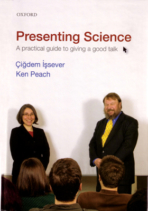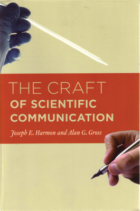Presenting Science: A Practical Guide to Giving a Good Talk by Çiğdem IŞsever and Ken Peach, OUP. Hardback ISBN 9780199549085, £39.95 ($75). Paperback ISBN 9780199549092, £19.95 ($35).
The Craft of Scientific Communication by Joseph E Harmon and Alan G Gross, Chicago University Press. Hardback ISBN 9780226316611, $55. Paperback ISBN 9780226316628, $20. E-book ISBN 9780226316635, $7–$20.

Communication takes many forms, each with its own “how to” manual. Peer-to-peer, communication with the media, reaching exhibition visitors and the public in general: all now have their guides. Each audience deserves particular attention, but the ground rules are always the same: define your objectives, work out a strategy for achieving those objectives and then plan your tactics. This approach comes across loud and clear in these two very different books.
Physicists Çiğdem IŞsever and Ken Peach give a practical guide to preparing a talk, while science communicators Joseph Harmon and Alan Gross take a rather more academic look, focusing on the craft of writing a scientific paper.
IŞsever and Peach deserve high praise not only for producing this book, but also for recognizing that communication skills are important enough to be taught to science students: their book is based on a course they deliver at the University of Oxford. Their key message is to be prepared: know who your audience is, why you are talking to them and what messages you want them to carry away. “The aim,” they write, in bold text, “is to get your message across to your audience clearly and effectively.”
The book walks its readers through the steps towards achieving that goal, urging would-be speakers to research the event that they’ll be talking at and the audience they’ll be talking to, before giving advice on how to prepare the ubiquitous PowerPoint presentation. “The purpose of the slides,” reads chapter two, “is to help the audience understand the subject. Once you start to relax on this and make the slides serve some other purpose (like being intelligible to those who were not there) you risk confusing the audience.” In other words, choose your message, package it for your audience and stick to it. It’s good advice.
Later chapters develop key themes. Chapter three talks about structure: tell people what you’re going to say, say it and then remind them of what you’ve said. Chapter four develops the theme of understanding the audience’s needs, while chapter five addresses style: if you’re talking to an audience of particle physicists, for example, you’ll adopt a different style from what you would choose for school pupils.
IŞsever and Peach are somewhat disparaging about the use of corporate image, arguing that it takes up too much space and leaves little for content. In corporate communication, this is often the case, but it doesn’t have to be that way. Whether we like it or not, the word “branding” has entered the lexicon of communication in particle physics: we’re all jostling for a place in the public’s consciousness, and brand identity helps. Establishing the brand has been a key ingredient of CERN’s communication, for example, throughout the start-up phase of the LHC. Partly as a result, CERN and the LHC are fast becoming household names, providing a strong platform on which to build scientific and societal messages.
The book winds up where it began: reminding readers that the key to success is thorough preparation. Like much of the book’s advice, this applies equally well to any form of communication, be it with lab visitors, journalists or even your neighbours.

Harmon and Gross take an altogether more academic approach, analysing and dissecting the scientific paper through the ages to identify and codify what works and what doesn’t. It is the classic textbook to IsŞsever and Peach’s field guide, each chapter ending with exercises for the student.
It’s a bold thing to attempt to improve on some of the most successful papers of the 20th century, but on page 22 Harmon and Gross do just that, while being careful to point out that their book was not subject to the same length constraints that a journal imposes. The point they make is that each part of a paper has a specific role to play, and by respecting that rule you’ll craft a better paper. A typical abstract, they argue, tells the reader what was done, how it was done and what was discovered. On page 22, they add a fourth element: why it matters. In doing so, the abstract becomes not only informative but also persuasive.
Harmon and Gross go on to apply the same rigorous approach to communications, ranging from grant proposals to writing for the general public, inevitably arriving at the subject of PowerPoint. In a chapter that resonates strongly with IŞsever and Peach, they point out a common failing of PowerPoint presentations: their creators often forget that audiences have only a minute or two to view each slide. Their key message? A PowerPoint slide is not a page from a scientific paper.
The book concludes with a final thought that, while most of us will never scale the intellectual heights of the great names of science, we can all aspire to approach them in terms of the clarity of our communication. These are two very different books on science communication, but their authors share a common belief that good science communication is a craft that can be learnt. Either one is a good place to start.





